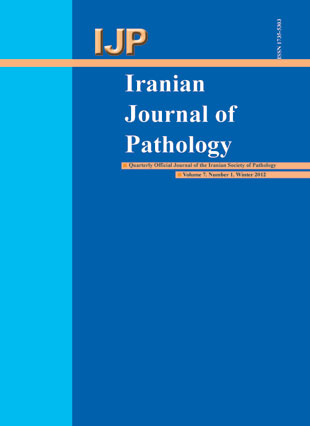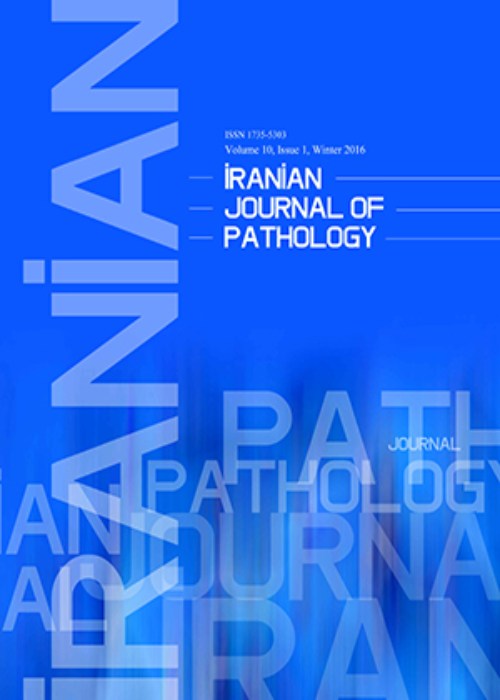فهرست مطالب

Iranian Journal Of Pathology
Volume:7 Issue: 1, Winter 2012
- تاریخ انتشار: 1390/10/11
- تعداد عناوین: 12
-
-
Page 3Background And ObjectiveIntraoperative consultation by frozen section is a high – risk procedure with important consequences. Therefore, it is critical to determine efficiency of frozen section performance periodically. This study was performed to determine the accuracy of frozen section in Urmia University of Medical Sciences.Keywords: Frozen Section, Specificity, Sensitivity
-
Page 9Background And ObjectivesHuman T-cell lymphotropic viruses (HTLV) type 1 and 2 are retroviruses that share the same routes of transmission as human immunodeficiency virus (HIV). As a consequence of epidemiologic similarities, HIV and HTLV-1/2 co infection is frequent. Due to the limited data, this study assessed the seroprevalence of HTLV-1/2 infections in HIV infected patients in Tehran, Iran.Materials And MethodsThis case-control study was carried out in 180 HIV infected patients from Iranian HIV/AIDS Research Center in Tehran and 117 matched healthy controls. The serum samples were checked with enzyme-linked immunosorbent assay (ELISA) for anti HTLV-1/2.ResultsA total of 180 HIV positive patients with mean age 36.9±9.2 years and 117 matched controls were enrolled in the study. All cases and controls were negative for HTLV-1/2 infection.ConclusionHTLV-1/2 infection is negligible in HIV infected patients in Tehran, Iran, although intravenous drug use is the most common route of HIV transmission in our study subjects.Keywords: HTLV, 1, HTLV, 2, Human Immunodeficiency Virus (HIV)
-
Page 14Background And ObjectivesType 2 diabetes is the most prevalent form of diabetes mellitus and is associated with a variety of complications. Homocysteine is an important independent risk factor for atherosclerotic diseases in both diabetic and non diabetic subjects. The association between these two is still unclear. The aim of this study was to assess the serum homocysteine levels in uncomplicated type 2 diabetic patients and control subjects.Materials And MethodsEighty five diabetic patients and 85 healthy control subjects with the mean age of 57.65 and 57.68 years, respectively, were selected during 2010 in Ahwaz City, southwest of Iran. Serum glucose, lipids and lipoproteins were measured by standard enzymatic techniques and homocysteine levels by enzyme –linked immunosorbent assay method.ResultsIn patients as a whole and with respect to the gender, homocysteine levels were generally lower than controls. Compared to other studies, homocysteine levels ranging from 12.19 to 18 μmol/l were slightly higher in both population.ConclusionHomocysteine levels, however, were compatible with normal range of adults. The patients were not nephropathic and it is most likely that this is the main reason for maintaining the normal levels. Slightly higher levels of homocysteine in the region are due to multiple genetic and environmental factors.Keywords: Type 2 Diabetes Mellitus_Homocysteine
-
Page 19Background And ObjectivesBeta-thalassemia continues to be a cause of significant burden to the society particularly in the poorer developing countries. Although sophisticated methods of screening have become available, a hunt for a cheap, rapid, objective screening method still remains elusive. Thus, the objectives are to study the validity of Naked-Eye-Single-Tube-Osmotic- Fragility-Test (NESTROFT) in detection of beta-thalassemia carrier state, to assess the prevalence of beta thalassemia trait among antenatal mothers in the region and also to find out the effect of concurrent iron deficiency on the hematological parameters in these cases.Materials And MethodsA total of 500 antenatal mothers in a rural tertiary care hospital were selected for the study. Their blood samples were subjected to NESTROFT, complete hemogram, reticulocyte counts and hemoglobin variant studies by electrophoresis and by high pressure liquid chromatography (HPLC). Serum ferritin estimation was done in cases diagnosed as beta-thalassemia trait. The results were analyzed statistically.ResultsA prevalence of 3.4% of beta-thalassemia trait and 0.6% of E-beta-thalassemia were observed among the study population. NESTROFT showed an overall sensitivity and specificity of 95% and 95.8% respectively in detection of heterozygous and double heterozygous states of beta-thalassemia. The various RBC indices were significantly (P <0.05) lower in carriers with concurrent iron deficiency. A co-existent iron deficiency did not preclude a diagnosis of betathalassemia carrier state.ConclusionsNESTROFT appears to a valid test in rural setting with financial constraints. The hematological parameters in iron deficient beta-thalassemic carriers significantly differed from their iron replete counterparts but did not cause problem in diagnoses.Keywords: Beta Thalassemia, Carrier States, Screening
-
Page 27Background And ObjectivesHIV infected patients are at risk for vaccine-preventable infections such as tetanus and diphtheria (Td). In these patients, these antibodies tend to decline faster. Due to the limited data, this study assessed the seroprevalence of tetanus and diphtheria antibodies in HIV infected patients in Tehran, Iran.Materials And MethodsThis case-control study was carried out in 180 HIV infected patients fromIranian HIV/AIDS Research Center in Tehran and 90 matched healthy controls. The serum sampleswere checked with ELISA for tetanus and diphtheria antibodies.ResultsA total of 180 HIV positive patients with mean age 36.9±9.2 years and 90 matched controls were enrolled in the study. Tetanus antibody was lower in HIV group when compared with control group. There was no significant difference in the mean serum levels of diphtheria antibody in HIV positive patients when compared with the controls. About 93.3% and 96.6% of HIV infectedpatients had protective diphtheria and tetanus antibodies respectively. Mean tetanus and diphtheriaantibodies levels were not significantly different based on the circulating CD4+ cells.ConclusionHIV positive cases, who had received primary Td vaccination before they contractedHIV infection, can be expected to be protected against diphtheria, whereas revaccination against tetanus must be considered.Keywords: Tetanus, Diphtheria, Human Immunodeficiency Virus
-
Page 32Background And ObjectiveEarly diagnosis of Streptococcus agalactiae remains difficult, since symptoms are very nonspecific. Its frequency has not been completely investigated in urinary tract pathogen of pregnant ant and non pregnant women in Iran. The aim of this study was determining the frequency of Group B Streptococci in female patients.Materials And MethodsA Total of 11800 urine specimens were received from female out-patients admitted during June till December 2010. Group B Streptococci isolates were confirmed by typical colony morphology, and identified by differential tests as well as by the growth characteristics in chromoagar. A provisional urinary tract infection diagnosis was defined by the presence of single group B Streptococci (>10 CFU/liter) with at least one of urinary tract infection symptom. Susceptibility testing was carried out by disk diffusion method.ResultsOf all specimens 498 specimens (4.22%) yielded significant bacteriuria caused by group B Streptococci. The mean age of these patients were 26.6 ± 19.37. Pregnant patients were 3.82% and the rest were non-pregnant. Antibiotic susceptibility test revealed that vancomycin, clindamycin and cefazolin had the lowest and penicillin showed the highest resistant rate.ConclusionPattern on antibiotic susceptibility test showed high resistant rate to some antibiotic that made it difficult for pregnant patients, although its frequency was low. It was not possible to compare the antibiotic susceptibility pattern of pregnant women with non pregnant because of the low number of pregnant women registered in this study.Keywords: Streptococcus Group B, Urinary Tract Infection, Microbial Sensitivity Test
-
Page 38We describe a rare case of laryngeal fasciitis ossificans. A 58-year-old man presented with hoarseness and a nodule was found in the larynx. Excisional biopsy was performed, and follow-up laryngoscopy showed complete resolution of this reactive lesion, and normal laryngeal function. The 0.6 cm diameter nodule was well circumscribed and histologically, the lesion was composed of uniform woven bone trabeculae with rimming of osteoblasts and cellular stroma. At the periphery, uniform spindle cells actively proliferated in edematous stroma. Spindle cells were immunoreactive for vimentin and α-smooth muscle actin, suggesting myofibroblastic differentiation. Fasciitis ossificans is histologically identical to myositis ossificans, but tends to present no zonation phenomenon. Fasciitis ossificans is a rare form of heterotopic bone formation, commonly presenting with signs of local inflammation or pain. This patient’s successful outcome suggests that conservative resection may be both diagnostic and curative.Keywords: Myositis ossificans, Larynx, Fasciitis
-
Page 43Leiomyoma of nasal cavity is a rare and benign tumor of smooth muscle origin that uncommonly arises from the nasal septum. We present an unusual case of histopathologically diagnosed locally extensive leiomyoma of the nasal septum which was clinically and radiologically misdiagnosed as malignancy of the nasal cavity. This case report emphasizes the rare occurrence of this entity at this site and highlights the need to consider this pre operatively to avoid its associated significant bleeding and altogether different clinical management of this benign entity.Keywords: Leiomyoma, Nasal Septums
-
Page 48Leiomyoma is a rare benign neoplasm deriving from smooth muscle. Vascular leiomyoma is its most common subtype in the oral cavity. It may appear at any age with the greatest incidence in the 4th and 5th decade of life. The common manifestation is a slow-growing, asymptomatic, submucousal mass. The diagnosis is only through microscopic examination requiring special staining. Treatment of choice is surgical excision and no recurrence is usually seen. In this report, we present a case of angiomyoma in the midline of hard palate with description of its clinical, histological and immunohistochemical characteristics.Keywords: Angiomyomas, Hard Palate, Leiomyoma
-
Page 53Pulmonary aspergillosis is a well known entity occurring in immunocompetent persons. Cutaneous aspergillosis, on the other hand, has been described in cases of suppressed immunity. Recently, invasive aspergillosis has been reported in patients with subtle immune dysfunction such as those with critical illness and advanced cirrhosis. We report a case of scrotal aspergillosis in association with Fournier’s gangrene and necrotizing fasciitis in a patient with cirrhosis.Keywords: Scrotum, Aspergillosis, Liver Cirrhosis
-
Page 58The presence of a low level of M protein in the peripheral blood <3mg/dl which is below the required cut off for the diagnosis of plasma cell myeloma is known as monoclonal gammopathy of undetermined significance (MGUS). Elevated levels of serum M protein and detection of M band on serum protein electrophoresis (SPE) can occur in chronic diseases not related to B cell disorders and not always diagnostic for B cell dyscrasias. It can also be seen in non hematological malignancies as seen in our case. We present a case of MGUS in a 59yr male patient, previously diagnosed and surgically treated for carcinoma prostate and colon. Serum electrophoresis revealed an M Band – monoclonal protein of 1.9 mg/dl. Urine for Bence Jones proteins was negative and his skeletal X-rays did not reveal lytic lesions. Bone marrow aspiration revealed metastatic carcinoma. Plasma cells formed 1% of the bone marrow differential count.Keywords: Monoclonal Gammapathy of Undetermined Significance, Metastasis, Carcinoma


